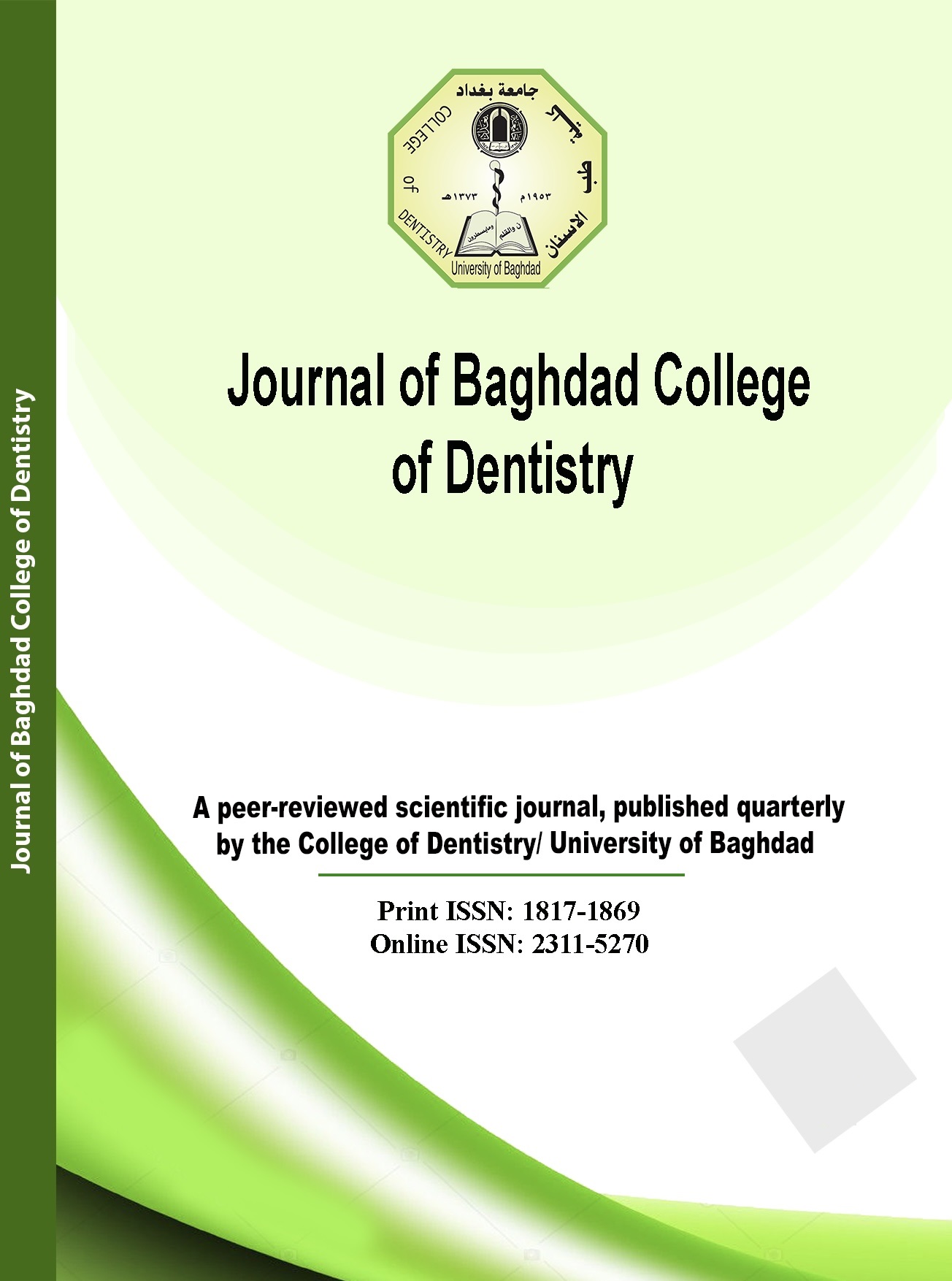Abstract
Background: The American Joint committee on Cancer in their 8th edition staging manual regarded perineural invasion
as one of the most important prognostic factors for Lip and Oral Cavity Squamous Cell Carcinoma, it also incorporated
tumor depth of invasion in defining tumor size category in the new staging system. This study was conducted to evaluate
the frequency of perineural invasion in oral squamous cell carcinoma and the effect of approaching tumor depth in this
process.
Materials and Methods: fifty-four formalin fixed paraffin embedded tissue blocks of radical resections of Oral Squamous
Cell Carcinoma were cut and stained with Hematoxylin and Eosin stain, then evaluated for perineural invasion, with
estimation of tumor depth of invasion for each case.
Results: Perineural invasion was found in twenty-two cases of the study sample. The diameter of the largest nerve bundle
that showed perineural invasion was found to have a positive significant correlation with tumor depth of invasion
(p=0.025). Perineural invasion status in terms of (present, absent) showed a significant difference with patients’ age
(p=0.037), also showed a significant association with tumor site (p=0.004), however, this association was non-significant in
regard to tumor grade and stage (p=0.848, p=0.520) respectively.
Conclusion: The attacking potential of preceding tumor depth and those cancers affecting young individuals may be
reflected by the presence of neural infiltration by tumor cells. Tongue resected tumors should be carefully inspected for
this deceptive biological process.
as one of the most important prognostic factors for Lip and Oral Cavity Squamous Cell Carcinoma, it also incorporated
tumor depth of invasion in defining tumor size category in the new staging system. This study was conducted to evaluate
the frequency of perineural invasion in oral squamous cell carcinoma and the effect of approaching tumor depth in this
process.
Materials and Methods: fifty-four formalin fixed paraffin embedded tissue blocks of radical resections of Oral Squamous
Cell Carcinoma were cut and stained with Hematoxylin and Eosin stain, then evaluated for perineural invasion, with
estimation of tumor depth of invasion for each case.
Results: Perineural invasion was found in twenty-two cases of the study sample. The diameter of the largest nerve bundle
that showed perineural invasion was found to have a positive significant correlation with tumor depth of invasion
(p=0.025). Perineural invasion status in terms of (present, absent) showed a significant difference with patients’ age
(p=0.037), also showed a significant association with tumor site (p=0.004), however, this association was non-significant in
regard to tumor grade and stage (p=0.848, p=0.520) respectively.
Conclusion: The attacking potential of preceding tumor depth and those cancers affecting young individuals may be
reflected by the presence of neural infiltration by tumor cells. Tongue resected tumors should be carefully inspected for
this deceptive biological process.
Keywords
carcinoma
tumor
Abstract
اعتبرت اللجنة الأمريكية المشتركة المعنية بالسرطان في كتيبها التدريبي للطبعة الثامنة أن انتشار الخلايا السرطانية المحيط بالعصب هو أحد أهم العوامل النذيرة
لسرطان الخلايا الحرشفية للشفة والتجويف الفمي، كما أضافت عمق الورم في تحديد فئة حجم الورم في نظام التدريج السرطاني الجديد. أجريت هذه الدراسة لتقييم تواتر
انتشار الخلايا السرطانية المحيط بالعصب في سرطان الخلايا الحرشفية الفموي وتأثير زيادة عمق الورم في هذه العملية .
المواد وطرائق العمل: تم قطع أربعة وخمسون حالة من سرطان الخلايا الحرشفية الفموي المستاصلة جذريا والمطمورة بشمع البارافين و صبغها بالهيماتوكسلين
والايوسين، ومن ثم تقييمها لانتشار الخلايا السرطانية المحيط بالعصب مع تقدير عمق الورم لكل حالة .
النتائج: اظهرت الدراسة اثنين وعشرين حالة من الانتشار السرطاني المحيط بالعصب وكان هناك علاقة ذات دلالة إحصائية بين اكبر قطر للحزمة العصبية التي اظهرت
انتشارا سرطانيا مع عمق الورم حيث ان (p=0.025) ، كما اظهرت الدراسة علاقة ذات دلالة احصائية بين حالة الانتشار السرطاني المحيط بالعصب مع عمر المرضى
(p=0.037) وكذلك مع موقع الورم (p=0.004) ، في حين لم تظهر الدراسة اي علاقة ذات دلالة احصائية مع مرتبة ومرحلة الورم (p=0.848, p=0.520) على
التوالي .
الاستنتاجات: ان الامكانية الهجومية التي تترافق مع زيادة عمق الورم وكذلك الاورام التي تصيب الافراد الشباب قد تنعكس عبر تسلل الخلايا السرطانية المحيط
بالعصب. كما يجب فحص أورام اللسان المصابة بعناية لهذه العملية البيولوجية الخادعة
لسرطان الخلايا الحرشفية للشفة والتجويف الفمي، كما أضافت عمق الورم في تحديد فئة حجم الورم في نظام التدريج السرطاني الجديد. أجريت هذه الدراسة لتقييم تواتر
انتشار الخلايا السرطانية المحيط بالعصب في سرطان الخلايا الحرشفية الفموي وتأثير زيادة عمق الورم في هذه العملية .
المواد وطرائق العمل: تم قطع أربعة وخمسون حالة من سرطان الخلايا الحرشفية الفموي المستاصلة جذريا والمطمورة بشمع البارافين و صبغها بالهيماتوكسلين
والايوسين، ومن ثم تقييمها لانتشار الخلايا السرطانية المحيط بالعصب مع تقدير عمق الورم لكل حالة .
النتائج: اظهرت الدراسة اثنين وعشرين حالة من الانتشار السرطاني المحيط بالعصب وكان هناك علاقة ذات دلالة إحصائية بين اكبر قطر للحزمة العصبية التي اظهرت
انتشارا سرطانيا مع عمق الورم حيث ان (p=0.025) ، كما اظهرت الدراسة علاقة ذات دلالة احصائية بين حالة الانتشار السرطاني المحيط بالعصب مع عمر المرضى
(p=0.037) وكذلك مع موقع الورم (p=0.004) ، في حين لم تظهر الدراسة اي علاقة ذات دلالة احصائية مع مرتبة ومرحلة الورم (p=0.848, p=0.520) على
التوالي .
الاستنتاجات: ان الامكانية الهجومية التي تترافق مع زيادة عمق الورم وكذلك الاورام التي تصيب الافراد الشباب قد تنعكس عبر تسلل الخلايا السرطانية المحيط
بالعصب. كما يجب فحص أورام اللسان المصابة بعناية لهذه العملية البيولوجية الخادعة
